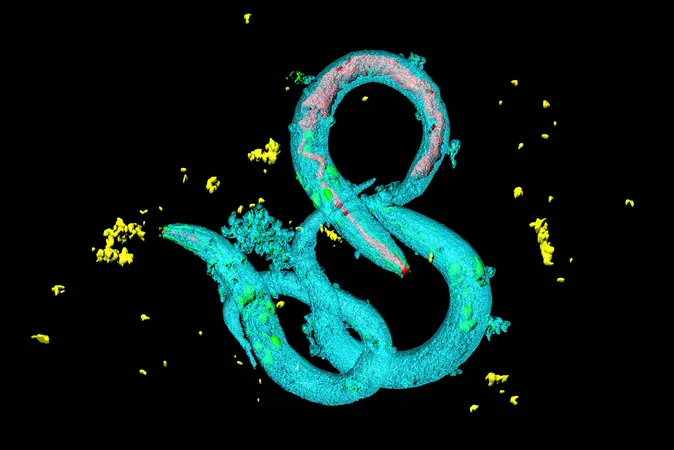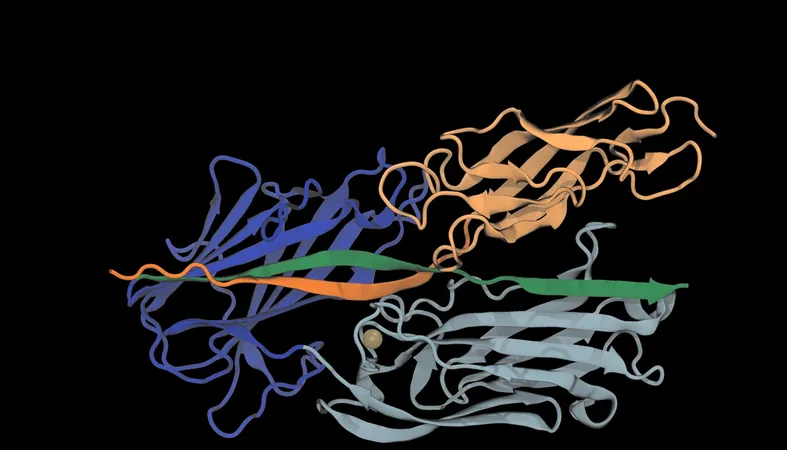
Worms Hit the Snooze Button When Faced with Predators!
2025-09-11
Author: Sarah
In a dramatic twist of fate beneath the microscope, the tiny nematode worm, Caenorhabditis elegans, faces off against its nemesis: the nematode-trapping fungus, Arthrobotrys oligospora. Under siege, these worms initially fight tooth-and-nail to break free from the fungus's deadly grasp, but then they suddenly go completely still, as if slipping into a deep, serene sleep.
The Struggle Turns Silent
Researchers from Academia Sinica in Taiwan and the Max Planck Institute for Biology in Tübingen observed this peculiar behavior. "We watched the worms struggling relentlessly for 15 to 20 minutes before they just stopped, as if they had surrendered," explained Yen-Ping Hsueh, one of the study's lead authors.
A Sleep Circuit Used for Survival
C. elegans, with its transparent body and a mapped brain of 302 neurons, offers a unique insight into these predator-prey interactions. Thanks to its genetic make-up and rapid life cycle, scientists were able to pinpoint the circuitry that triggers this sudden stillness.
It turns out that this switch represents a sleep circuit adapted for survival. When physically trapped, the worm's touch-sensing neurons fire up, sending distress signals to two crucial brain hubs—the ALA and RIS neurons. Once activated, these cells induce a quiescent, almost hibernation-like state where the worm stops moving, feeding, and conserves energy while waiting for its fate.
An Ancient Alarm System Reimagined
The mechanism behind this is linked to the epidermal growth factor receptor (EGFR) pathway, a stress-response signaling system that’s been conserved throughout evolution. This research confirms that not only does being physically captured trigger these neurons, but so do other threats like injury or extreme temperatures.
Interestingly, this dual mechanism—mechanosensation working in tandem with the EGFR signaling pathway—works like a safety net to ensure the worm only enters this protective state when absolutely necessary. As Hsueh notes, "In a world where second chances are rare, a false alarm could be deadly, making this precaution critical for survival."
Stillness: An Unconventional Defense Mechanism
But why choose to freeze? For many animals, stillness can reduce the chances of being detected by predators. For a worm caught in a tight spot, remaining motionless might also save energy or prevent additional harm. Strikingly, scientists are still determining whether this freeze response ultimately aids the worm or simply benefits the hungry fungus.
Researcher Tzu-Hsiang Lin expresses a keen interest in understanding this complex interaction further, stating, "We need to explore whether this behavior is genuinely beneficial for the worm or just a way to make it easier for the fungus to secure a meal."
Unlocking Secrets of Predator-Prey Dynamics
The idea that stress triggers sleep-like behavior in worms isn’t new, but only recently have scientists gained the tools necessary to dissect this intricate predator-prey relationship. Combining precise neuronal manipulations with the study of Arthrobotrys allowed the team to illustrate how touch and stress signals converge to initiate this behavior.
Insights into Evolution and Survival
This remarkable research not only sheds light on nematodes and fungi but also highlights the extraordinary adaptability of evolutionary circuits, repurposing neural pathways for survival strategies against predators. It marks a pivotal moment in our understanding of sleep as an active, regulation-driven state rather than a mere passive downtime.
As Hsueh aptly remarks, this study illustrates how brains intricately weave together external threats with internal states like sleep, offering both neuroscientists and ecologists a closer look at survival tactics at a cellular level. Beyond the scientific intrigue, it reminds us just how much complexity—and drama—unfolds in the natural world, even at the smallest of scales.




 Brasil (PT)
Brasil (PT)
 Canada (EN)
Canada (EN)
 Chile (ES)
Chile (ES)
 Česko (CS)
Česko (CS)
 대한민국 (KO)
대한민국 (KO)
 España (ES)
España (ES)
 France (FR)
France (FR)
 Hong Kong (EN)
Hong Kong (EN)
 Italia (IT)
Italia (IT)
 日本 (JA)
日本 (JA)
 Magyarország (HU)
Magyarország (HU)
 Norge (NO)
Norge (NO)
 Polska (PL)
Polska (PL)
 Schweiz (DE)
Schweiz (DE)
 Singapore (EN)
Singapore (EN)
 Sverige (SV)
Sverige (SV)
 Suomi (FI)
Suomi (FI)
 Türkiye (TR)
Türkiye (TR)
 الإمارات العربية المتحدة (AR)
الإمارات العربية المتحدة (AR)